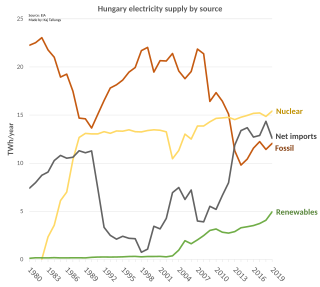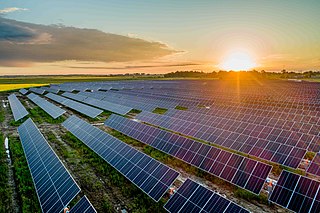Energy types
Renewable energy
According to the International Renewable Energy Agency (IRENA), in 2020, renewable energy accounted for 32% of Estonia's Total Energy Supply (TES). The composition of this renewable energy mix was heavily dominated by bioenergy, which represented 93% of renewables. Wind energy made a 5% contribution, and hydro and marine sources combined for 2%, with solar energy having a minimal impact. [1]
| Achievement | Year | Achievement | Year | Achievement | Year |
|---|---|---|---|---|---|
| 30% | 2019 | 35% | 2020 | 40% | 2020 [7] |
| | This section needs expansion. You can help by adding to it. (February 2024) |
Biomass
In 2020, biomass constituted 29.8% of Estonia's Total Energy Supply (TES). This figure was derived from the renewable energy sector's 32% contribution to the TES, with biomass making up 93% of the renewable energy mix [1] .
Wind
Wind power had a capacity of 320MW in 2020 however investment continues with a €200m 255MW Sopi-Tootsi wind project planned to be operational by 2024. [10]
Solar
Solar power has received investment since 2014. In 2022, Estonian solar power plants produced 2,569 gigawatt-hours (GWh) of renewable energy. 26 million euros were paid in subsidies for electricity produced via solar power in 2022. [11]
Hydro
In August 2022, Eesti Energia announced the start of development for Estonia's first pumped-storage hydroelectric power plant (PSH). The project is located in the Estonia Mine industrial area in Ida-Virumaa and aims to become operational by 2026. Designed to utilize mining residues and closed oil shale mining tunnels, the project has a planned capacity of 225 MW. It aims to enhance energy security and the stability of the power network, particularly in anticipation of Estonia's planned disconnection from the Russian energy system. The plant is expected to act as a significant energy storage unit, facilitating the integration of renewable energy into the grid. [12]
Fossil fuels
Oil-shale
Oil-shale powered generators in 2019 accounted for 70% of electricity generation in Estonia. [13]
The original target to reduce production from oil-shale was 2035 with production ceasing by 2040, has been changed to ceasing oil-shale production by 2030. [14]
Between 2018 and 2022 oil-shale extraction and use reduced by 50%. [15]
The country's reliance on oil shale has decreased but remains its primary energy source. Between 2011 and 2021, the share of oil shale dropped from 71% to 60% in total energy supply and from 85% to 48% in electricity generation, rebounding to 57% in 2022. This reduction improved Estonia's carbon intensity, dropping it from the 3rd highest in the IEA in 2017 to the 18th highest in 2022. [6]
Natural gas
Estonia has the Balticconnector pipeline, which links Estonia with Finland.
In April 2022 Estonia reduced gas imports from Russia and on 29 September 2022 Estonia banned buying natural gas from Russia. Work began on LNG facilities at Paldiski which was completed in October 2022 and increased transmission capacities in existing interconnection points. [16] [17]
In December 2022 a floating LNG terminal became operational in Finland which connects to Estonia. [18]















